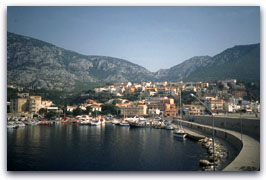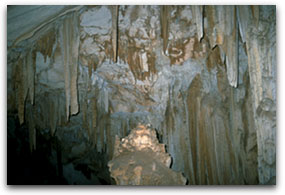Sailing southward we reach the
beautiful and long beach of Posada. On the top of the hill which rises from the beach the
village has been built. It has an ancient Medieval quarter and the Castello della Fava where
Eleonora d'Arborea lived.
The sea bed is sandy because of the beaches and continues to be so as far
as La Caletta di Siniscola and
the Marina di Orosei, beyond which the coast rises suddenly in calcareous cliffs
that are not easy to reach by land.
|
|

 Cala Gonone Cala Gonone |
Cala Gonone (the
only inhabited part of this coast) which is part of the "comune of Dorgali" has a small harbour which is always
crowded in the summer and is linked by a tunnel that goes through Mount Bardia to
Dorgali.
|

 Dorgali - Grotta del Bue Marino Dorgali - Grotta del Bue Marino |
|
This is a big village that rises on
the slopes of the mountain. This area is full of ancient Nuragic settlements and a visit to the
Grotte di Ispingoli is worthwhile. Inside this cave there is an enormous column, 38 metres high,
formed by a stalactite and stalagmite. It is the highest column in Europe.
The most famous marine places near Cala Gonone are the Grotta del Bue Marino and Cala Luna
the destination of the first part of this our "navigation" along the coast of Sardinia.
The Cave is called "Del Bue Marino" because it has always been inhabited by monk seals.
It is 2 kms. from the port of Cala Gonone.
|
It is possible to visit the cave through the long
tunnel cut out of the calcareous rock which leads to a small lake with small beaches and an
underground stream among a large variety of concretions of incredible shapes.
Going southwards, not far from the caves, the rock opens to give space to Cala Luna: a rare
natural jewel formed by very beautiful beach bordered by a pond and oleander bushes that
make a scenery envied by the whole world.
|
|

 Cala Luna Cala Luna |
|